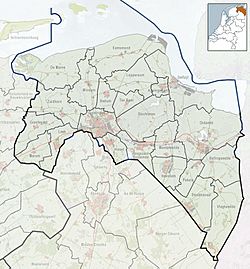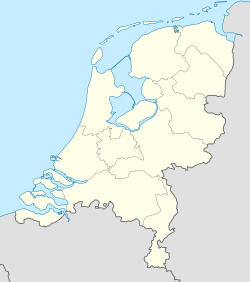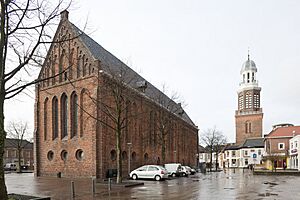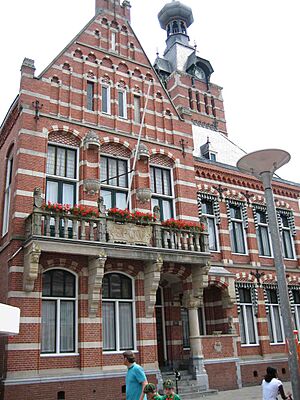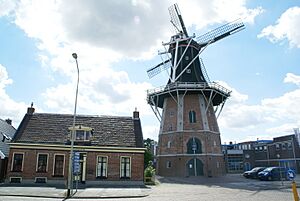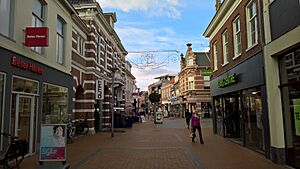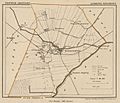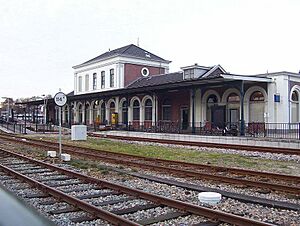Winschoten facts for kids
Quick facts for kids
Winschoten
Winschoot (Gronings)
|
|||||
|---|---|---|---|---|---|
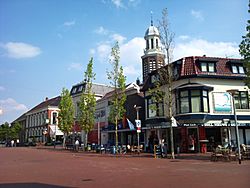
City center of Winschoten in 2010
|
|||||
|
|||||
| Nickname(s):
Sodom, Molenstad
|
|||||
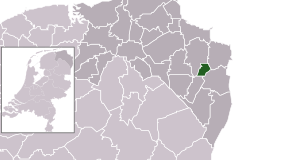
Location in Groningen
|
|||||
| Country | Netherlands | ||||
| Province | Groningen | ||||
| Municipality | Oldambt | ||||
| Area
(2006)
|
|||||
| • Total | 22.24 km2 (8.59 sq mi) | ||||
| • Land | 21.66 km2 (8.36 sq mi) | ||||
| • Water | 0.58 km2 (0.22 sq mi) | ||||
| Population
(1 January 2007)
|
|||||
| • Total | 18,518 | ||||
| • Density | 832.64/km2 (2,156.5/sq mi) | ||||
| Time zone | UTC+1 (CET) | ||||
| • Summer (DST) | UTC+2 (CEST) | ||||
| Postal code |
9670–9675
|
||||
| Area code(s) | 0597 | ||||
Winschoten is a city in the northeast of the Netherlands. It is part of the Oldambt municipality. About 18,500 people live here.
Winschoten is the biggest city in the Oldambt area. This region is located in the province of Groningen. Winschoten became a city in 1825. It was its own municipality until 2010. Now, it is the main town for the Oldambt municipality.
The city has three old windmills and several churches. There is also a train station. You can travel from here to Groningen and Leer in Germany. Winschoten is an important place for shopping in the Oldambt region. Many people from nearby Germany also come here to shop.
Contents
What's in a Name? Winschoten's Nicknames
The exact meaning of the name Winschoten is not fully known. However, the city has some interesting nicknames! One popular nickname is Molenstad, which means Milltown. This name comes from the many windmills that used to be in the area.
Another old nickname for Winschoten was Sodom. This name was used by the Jewish community who lived there. They felt that some of their non-Jewish neighbors behaved in ways they found surprising. The people of Winschoten are also sometimes called Tellerlikkers. This means "plate lickers" in their local dialect.
Winschoten's Location and Symbols
Winschoten is located in a very fertile farming area. It received its city rights in 1825. This was more of a symbolic gesture, as it was the last town in the Netherlands to get these rights.
The city flag has three blue and white stripes. In the middle white stripe, there is a red outline of a fortress. This flag was chosen in 1973. The city's coat of arms shows an image of Saint Vitus. You can find his name in many street names and school names around Winschoten.
Winschoten is in the eastern part of the Groningen province. It is in the northeast of the Netherlands. The city is east of Groningen, Hoogezand, and Veendam. It is north of Stadskanaal and south of Delfzijl. To the west are Leer and Papenburg in Germany. Winschoten is also south of the Dollart and the Oldambtmeer lake.
Historic Windmills of Winschoten
Winschoten used to have 13 windmills! Today, only three large, historic windmills remain. The local council owns these mills. Volunteer millers keep them running. These mills are an important part of the city's look. They are well cared for so everyone can enjoy them.
Molen Berg: A Corn Grinding Mill
Molen Berg was built in 1854. It was designed to grind corn. This mill had a special design for its sails. They had movable blades, like Venetian blinds. This was very advanced for its time. Most Dutch windmills used tarpaulin covers on their sails to control the wind.
Dijkstra Molen: A Restored Landmark
The Dijkstra Molen was built in 1862. In 1953, the grandson of the first owner sold it to the local government. The mill was restored in 1982-1983. More restoration work happened in 1995-1996.
Molen Edens: The Oldest Mill
Molen Edens was built in 1763. It is the oldest mill in the entire province of Groningen. The Edens family owned it for many years, from 1855 until 1960. The local municipality bought it in 1960.
Churches and Community History
Winschoten has many Protestant churches. The oldest church dates back to the 13th century. It mixes Roman and Gothic styles. There is also a Dutch Reformed church on Marktplein. A bell tower from the 16th century stands freely nearby. It is a famous part of the Winschoten skyline.
There is also a Roman Catholic church. It is dedicated to Saint Vitus. This church was built in 1880. It has beautiful stained glass windows. It also has a special sandstone altar. This altar was moved here from another church.
Winschoten once had a large Jewish community. Sadly, during World War II, many Jewish people from Winschoten were taken away. Only a small number of the 493 Jewish residents survived the war.
The Tellerlikker Monument
The nickname tellerlikker means "plate licker." It came from a local custom. People would eat their meals very quickly. They would even lick their plates clean! A monument to one of these "plate lickers" stands in Oldambt Square. It shows a person eating, with a dog licking their feet.
Language in Winschoten
The official language in Winschoten is Dutch. However, many older residents speak a local dialect called Gronings. Many people can also speak German or English. The Winschoter version of Gronings has words from Hebrew and Yiddish. This is because of the Jewish community that lived there for a long time.
Sports and Events
Winschoten hosts the oldest Ultramarathon in the Netherlands. It is called De RUN and started in 1976. This is a 100-kilometer race. Runners complete ten 10-kilometer laps through the town. The current record is 6 hours, 16 minutes, and 41 seconds. This event usually happens on the second Saturday of September. You can also run a 50-kilometer race or join a 10x10 km relay race with a team.
Winschoten also hosted the start and finish of the first stage of the 2013 Energiewacht Tour. This was a cycling race.
Getting Around Winschoten
Winschoten has a train station. You can take trains to Groningen and Leer in Germany. The train station opened on May 1, 1868. It was part of a line connecting Groningen, Winschoten, and Nieuweschans. Today, the train services are run by Arriva.
Winschoten is also connected to the rest of the Netherlands and Germany by road. The A7 motorway (also known as E22) passes by the city.
Famous People from Winschoten
Winschoten has been home to several notable people:
- Wiebbe Hayes (born around 1608), a Dutch soldier and national hero.
- Arnold Hendrik Koning (1860-1945), a Dutch painter.
- Dirk Stikker (1897–1979), who was a Dutch minister and later the Secretary-General of NATO.
- Bernard D. H. Tellegen (1900–1990), a Dutch engineer and inventor.
- Jaap Meijer (1912–1993), a Dutch historian and poet.
- Herman Makkink (1937–2013), a Dutch sculptor and artist.
- Klaas Nuninga (born 1940), a Dutch footballer.
- Bas Jan Ader (1942–lost at sea 1975), a Dutch artist.
- Piet Hamberg (born 1954), a Dutch footballer and coach.
- Henriëtte Weersing (born 1965), a Dutch volleyball player.
- Marcel Hensema (born 1970), an actor.
- Bert Zuurman (born 1973), a Dutch footballer.
- Marnix Kolder (born 1981), a Dutch footballer.
- Marcel Seip (born 1982), a Dutch footballer.




